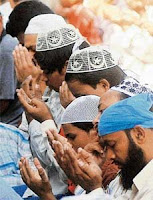RAMADAN (RAMZAAN)
>> Friday, July 3, 2009

Ramadan is a month long festival, celebrated by Muslims all over the world. It generally starts in the third week of August. The festival marks the auspicious time when the holy Muslim epic Quran, consisting of the tenets of Allah for his people, was revealed by Prophet Muhammad.
The five pillars of Islam, according to the holy Quran, ask the followers of Islam to believe in only one God Allah, to offer prayers five times a day, to fast during the month of Ramzaan called Roza, to pay annual tax called Zakat to be distributed to the poor and to go for pilgrimage to Mecca.
Being the third pillar of Islam, it is considered highly auspicious for the Muslims to pray to the Lord and observe fast during the festival of Ramzan, to show respect to Allah. It is the month when Muslims get into self introspection and resist their desires to devote themselves completely in the service of the Lord.
Celebrations of the festival include a thirty day fast broken in three parts, or Ashra. These are Rahmat or the mercy of God, Maghfirat or the forgiveness of God and Nijat which means salvation. Fasting starts with the dawn and is broken at dusk with family and friends. This meal is called Iftaar. Fasting not just includes resistance from food and water, but also need Muslims to abstain from greed, lust, gossips, backstabbing and sarcastic remarks that may hurt others. The auspicious festival requires purity of both thoughts as well as actions.
After the new moon is sighted on the thirtieth day, Eid-ul-Fitr is celebrated to mark an end to the fasting month. The festival brings all family and friends together. People wear new clothes and enjoy lavish meals, enjoying some happy moments together. The festive meal generally includes a sweet milk preparation called sevai and non vegetarian dishes like korma and kababs. Children are given money by their elders, as blessings. It is called Eidi. Charity is important on this festival and food and clothes are donated to the poor. This is known as Zakat-al-Fitr.
On this festival, the mosques are filled with crowds of people, who visit the mosque to offer their prayers to the lord, called Namaaz. They cover their heads with white caps and their heads and generally wear white pathani kurta-pyjama. Ladies wear salwar-suits and normally wear a burqa to cover their faces. Women offer their prayers at home only.
Ramadan is falling on 21st of August, 2009.
-by Shikha Priyadarshini
